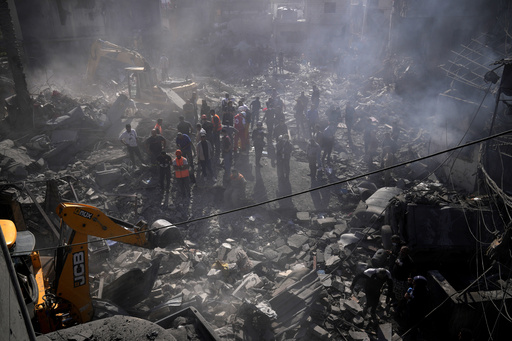
Israel Airstrike Devastates Beirut Neighborhood, Leaving Casualties and Destruction
In the aftermath of an Israeli airstrike that struck a crowded area adjacent to Beirut’s primary public hospital, rescue efforts were still underway nearly 16 hours later. Workers were sifting through the wreckage, using excavators to extract twisted metal and debris in a desperate search for victims.
Onlookers gathered amid the rubble, with some stating they feared an entire family was trapped underneath. Mohammad Ibrahim, a Sudanese individual, expressed his anguish as he searched for his brother, whose mobile phone continued to ring unanswered. “We are trying to find him. I don’t know if he is dead or alive,” he lamented.
As the day unfolded, health officials confirmed that five bodies had been retrieved from beneath the wreckage, with reports indicating at least 18 fatalities, including four children, and over 60 others injured as a result of the attack. The explosion also damaged the nearby Rafik Hariri University Hospital, which is the capital’s foremost medical facility.
Jihad Saadeh, the hospital’s director, reported that the airstrike shattered numerous windows and solar panels but fortunately, hospital operations continued without injuring any staff members. He mentioned that they received no prior notification regarding the impending strike that occurred just a few meters away. Residents of the densely populated slum, home to many migrant laborers and low-income Lebanese families, were also caught off guard.
The Israeli military asserted that the attack targeted a Hezbollah position, clarifying that it was not directed at the hospital itself. Access to the crash site proved difficult for rescue teams due to the narrow, dusty roads and the compact nature of the homes in the area.
One rescuer, Nizar, reported being on the scene since Monday evening and noted, “It was too dark and there was so much panic.” Many people were still trying to comprehend the situation and its severity. The landscape was littered with debris, fragmented furniture, and remnants of lives once lived, as residents searched through the remains for lost loved ones or possessions. There were armed guards present to maintain safety amid the chaos.
The Lebanese Civil Defense reported extensive structural damage, confirming that five buildings were completely destroyed and twelve others had severe harm. The victims included individuals of various nationalities, among them a Sudanese and at least one Syrian.
Nizar elaborated on the challenges faced by the rescue team, stating, “This is a very crowded area; buildings are very close. The destruction is massive,” underscoring how the devastation complicated their efforts. Meanwhile, across the street, the hospital was still treating some of those injured in the attack. The morgue had received 13 bodies by that time.
Nurse Hussein al-Ali, who was present during the airstrike, recalled the moment of impact, stating it took a few minutes for him to grasp that the hospital wasn’t the target. The lobby was engulfed in dust and smoke, with glass scattered throughout various hospital units and debris littering the floor above their heads. “We were terrified. This is a crime,” he declared. “It felt like judgement day.”
Minutes after the blast, injured individuals from the area began arriving at the hospital. Al-Ali recounted feeling overwhelmed, having little time to collect himself or comfort his frightened colleagues and patients. “Staff and patients thought the strike was here. We fled outside as the injured were coming in,” he explained, reflecting on the grim task of later carrying the deceased neighbors back inside.
Ola Eid, who survived the airstrike, detailed her experience rushing to uncover her neighbors’ children from the debris, only to discover she herself was injured. “The issue is we didn’t feel it. They didn’t inform us,” she said, her bandaged wounds a testament to the chaotic scene. Eid, an actress, remembered playing with children when the initial explosion occurred; it knocked her to the ground, scattering candy she had been handing out. She stood in disbelief as she saw one child covered in blood; one tragically passed away while another was in critical condition.
“I looked ahead and saw the kids torn apart and hurt,” she recounted, describing the flames consuming gas canisters nearby. “I didn’t know what to do — put out the fire or remove the kids.” The horrifying events of that day left many residents grappling with loss and trauma in their shattered community.
